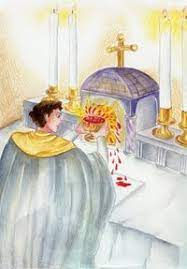The Catholic Defender: Christ Placed in the Tomb
- Donald Hartley

- Apr 2, 2021
- 4 min read

While Stationed at Fort Campbell KY, I was leading bible studies, protesting porno in Clarksville, and involved with the RCIA. One night I was listening to WAYFM Christian Radio based out of Nashville when they had an interview with a Christian singer, Rebecca St. James who spoke of her visit to the Latin American Country of Columbia. Rebecca was at a Christian bookstore signing autographs and promoting a CD when she spoke of her trip to Columbia. I was shocked when I heard her tell the audience that Catholics denied the Resurrection keeping Christ in the tomb.
Quickly, I began trying to phone in to explain what she totally misrepresented about Christ and the tomb. I did get through to the Station, but all she could do was receive my information because their time slot was over. I was frustrated that I was not able to correct Rebecca's misunderstanding.

As the days went by and time passed I basically forgot about it as I thought she had other more pressing problems like concerts and recordings. About two months had passed when one night the phone rang and it was Rebecca St. James calling me before she was to fly out of Chicago heading for her European tour.
What a pleasant surprise this was as I explained to Rebecca the devotion of the Stations of the Cross which you will find in every Catholic Church. That the devotion leads to the Resurrection, that there are a number of devotions that include the Resurrection.
Mostly, I wanted to erase any idea in her mind that Catholics worship a dead Christ? That Christ is totally alive.
Rebecca thanked me for giving her a better informed understanding of what she witnessed in Columbia. It was about a year later that Rebecca St. James and her troupe came near Fort Campbell Kentucky to play for the community. She remembered me from our discussion and it was a real blessing to have met her face to face with her group.

I basically explained the Stations of the Cross starting from the beginning. That the early Christians began following the footsteps of Christ to Calvary.
Pilgrims began making Jerusalem a place of pilgrimage when the Roman Emperor Constantine in 313 gave the Church freedom with his "Edict of Milan".
The Church of the Holy Sepulcher was built over the traditionally held belief where Christ was crucified and placed in the tomb. There is an old parchment written in the fourth century coming from a French woman named Egeria who made such a pilgrimage.
Led by the Bishop of Jerusalem, pilgrims gathered at the "first cockcrow" at the place where Jesus began His agony in the garden of Gethsemane. Egeria writes, "reaching the (city) gate about the time when one man begins to recognize another, and thence right on through the midst of the city. All, to a man, both great and small, rich and poor, all are ready there, for on that special day not a soul withdraws from the vigils until morning."

In time, the route known as the Via Dolorosa, the Sorrowful way, began where Pontius Pilate made his judgement heading to the Church of the Holy Sepulcher going through old Jerusalem.
In the middle ages, with the aggression coming from the Muslims, such pilgrimages became dangerous.
As a result, the Stations of the Cross became popular through the Franciscans at the local church. In the middle 14th century there were as many as 37 Stations, but it was not until Pope Innocent XI called on the Franciscans to formulate the Stations for their local churches in 1686 giving them an indulgence doing the Stations as if they were in the Holy Land.
In 1726, Pope Benedict XIII made the devotion accessible for all the faithful in all of Christendom. By 1731, Pope Clement XII fixed the number of 14 Stations that we see today. 1742 is important as Pope Benedict XIV promoted the 15th Station, the Resurrection be added ending at the Sanctuary of the Church. That is where the tabernacle resides.

The traditional 14 stations are as follows:
1. Jesus is condemned to death
2. Jesus carries his Cross
3. Jesus falls the first time
4. Jesus meets his afflicted mother
5. Simon of Cyrene helps Jesus carry his Cross
6. Veronica wipes the face of Jesus
7. Jesus falls the second time
8. Jesus meets the women of Jerusalem
9. Jesus falls a third time
10. Jesus is stripped of his clothes
11. Jesus is nailed to the Cross
12. Jesus dies on the Cross
13. The body of Jesus is taken down from the Cross
14. Jesus is laid in the tomb
St. Pope John Paul II introduced the Scriptural Way of the Cross for the Good Friday event taking place at the Colosseum in Rome and in 2007, Pope Benedict promoted this particular devotion for all the faithful.

Rebecca St. James was very appreciative hearing this as I told her about cultures giving their rich heritage such as the people of Poland walking the Stations.
The Blackfoot Indians on their Reservation would walk a seven mile trek with the oldest to the youngest who could carry a cross wearing their ancestral clothing.
This devotion is specifically to follow Our Lord in a spiritual walk enhancing our devotion to Our Lord's suffering and adding ours with his. Jesus said, "and I, when I am lifted up from the earth, will draw all men to myself." John 12:32
St. Paul writes, "but we preach Christ crucified, a stumbling block to Jews and folly to Gentiles, but to those who are called, both Jews and Greeks, Christ the power of God and the wisdom of God." 1 Corinthians 1:23





















Comments